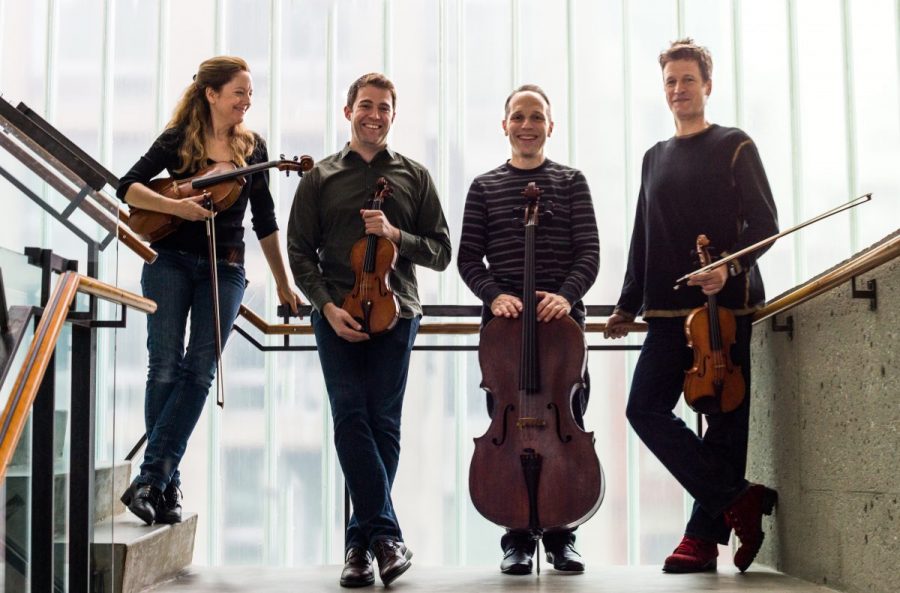@ The Usher Hall, Edinburgh, on Thu 27 Aug 2015
Nothing could be more eye-opening than attending a concert in high anticipation of its drama-fuelled second half (a familiar, well-loved symphony), to then find the first half completely shattering all previously held notions of what is worth making the effort to experience live. A piece of late Schoenberg, originally for wind band, alongside the albeit popular composer John Adams’s Absolute Jest – a work for string quartet and orchestra that sits somewhere murkily between the concerto, the symphony and chamber music – doesn’t appear, at a casual glance, to be a recipe for musical rapture.
As soon as conductor Michael Tilson Thomas guides the San Francisco Symphony orchestra through the opening bars of Schoenberg’s Theme and Variations, Op.43b, the lovingly crafted theme appears in such carefully coloured sequence that the audience can be in no doubt as to the assured care in which their listening experience rests. The brass and woodwind are warm but clearly articulated, and later, the cosying up of the cellos in the centre of the string section aids the tight-knit execution of these texturally varied, highly contrapuntal thematic elaborations.
No, the blundering, lugubrious tune is not much of an ear-worm – plenty of that in the Mahler to follow – but on this occasion it does unfold in a short-lived, stirring triumph towards its closing. Here, at full throttle, the orchestra’s sound is spectacular. The shock of the textural fullness and weight is peculiarly hair-raising, and the effectiveness of the live experience for properly conveying this transition is unusually vital in a piece of such textural complexity.
From the remarkably relaxed conducting style Tilson Thomas employs for much of the Schoenberg (the imposition of wilful control over some marked and exhilarating rallentando climaxes being an exception), he aptly moves to something more exacting to negotiate the tricky territory and unusual instrumental relationships that form John Adams’s Absolute Jest, a concerto for string quartet and orchestra. Adams substantially revised the score for this work after its premiere in 2012, his chief worry being the muddied boundaries of his instrumental forces and the resulting ‘chatter’.
The reworked version definitely puts to bed those anxieties: instrumental forces are used with economy, and none are extraneous. There are some especially beguiling transitions from the inner chamber group to the flanking outer forces that have the feel of a private meeting that gives way to public announcement. Adams finds new ways to denote structural juncture and change of landscape, mirroring, but altogether different from, the way Beethoven (from whom he steals his ‘tattoos’ – set musical fragments) might have used a key change.
All the players of the St Lawrence String Quartet play with a dedicated energy and sense of fun, and the efforts of none are lost within the grouping, despite their admittedly awkward placing. Their leader, Geoff Nuttall, is a violinist whose physical energy when both playing and listening seems to suggest that a chair is the last place from which this music should be appreciated. Sadly the orchestral strings seem a little inhibited towards the flying conclusion, perhaps too aware of their ‘outer’ supplementary role: a whole band of soloistic bravura might have propelled this whirlwind of breathlessly layered quotation to a more exuberant finish.
Comprising the concert’s second half is Mahler’s first symphony, that opens with a deservedly renowned evocation of nature: diaphanous, suspended string mists softly etch a daybreak overlaid by distant horn calls, birdsong and military fanfares. During this performance, as the flurries of movement increase, there is an immediate sense that the interpretation won’t wallow in the symphony’s eccentricities, its riotous capriciousness. Sometimes the ensuing folk-inflected numbers press forward too eagerly; a little more elasticity and ease would have added grace and tenderness to this symphonic spring, as would a heftier digging in of the heels for the Länder at the outset of the second movement have given a gutsier rusticity. It is all a little smoothed over, too well-refined.
Movements three and four however, suggest that Tilson Thomas’s eye has been on the darker underbelly of this symphony all along. The eerie minor mode ‘Frère Jacques’ that frames the third movement is shaped, as it unfurls into leaping upward fourths, in a cruelly brusque manner, pointing to the darkness to come. Always perched on the brink of a wholly uncontrollable volatility, the fourth movement lurches from tempo to tempo with schizophrenic energy, occasionally stuttering to brief stand-still, all deftly manoeuvred by the orchestra, and yet with a delicious sense of danger and wild risk. Amid the turbulence the Sehr gesangvoll (Very songful) section sits like a pocket of detached wistful beauty, with the San Francisco strings’ refined singing quality marvellously well suited to creating the poise of its resigned longing.
